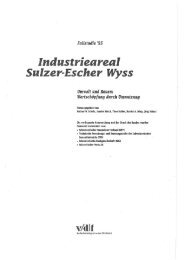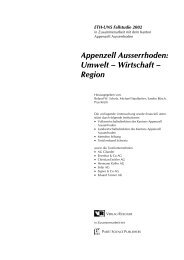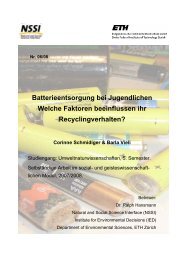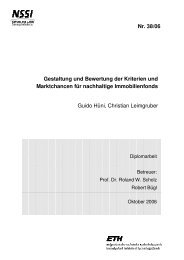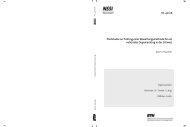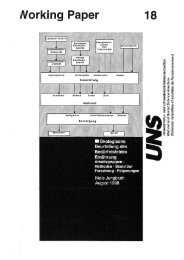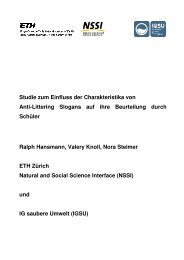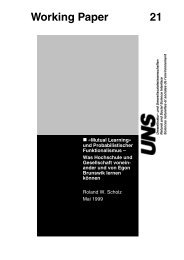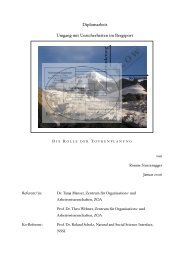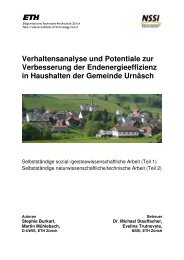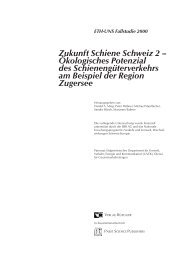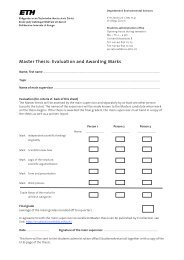The Paradigm of Human-Environment Systems - Natural and Social ...
The Paradigm of Human-Environment Systems - Natural and Social ...
The Paradigm of Human-Environment Systems - Natural and Social ...
You also want an ePaper? Increase the reach of your titles
YUMPU automatically turns print PDFs into web optimized ePapers that Google loves.
Working Paper 37<br />
� <strong>The</strong> <strong>Paradigm</strong> <strong>of</strong><br />
<strong>Human</strong>-<strong>Environment</strong><br />
<strong>Systems</strong><br />
Rol<strong>and</strong> W. Scholz <strong>and</strong><br />
Claudia R. Binder<br />
April 2003<br />
Umweltnatur- und Umweltsozialwissenschaften<br />
<strong>Natural</strong> <strong>and</strong> <strong>Social</strong> Science Interface<br />
Sciences naturelles et sociales de l'environnement
Publisher:<br />
Pr<strong>of</strong>. Dr. Rol<strong>and</strong> W. Scholz<br />
Umweltnatur- und<br />
Umweltsozialwissenschaften (UNS)<br />
ETH Zentrum HAD<br />
Haldenbachstrasse 44<br />
CH-8092 Zürich<br />
Tel. ++41-1-632 5892<br />
Fax ++41-1-632 10 29<br />
E-mail: scholz@uns.umnw.ethz.ch<br />
Authors:<br />
Pr<strong>of</strong>. Dr. Rol<strong>and</strong> W. Scholz<br />
Umweltnatur- und<br />
Umweltsozialwissenschaften (UNS)<br />
ETH Zentrum HAD<br />
CH-8092 Zürich<br />
Tel. ++41-1-632 58 91<br />
Fax ++41-1-632 10 29<br />
E-mail: scholz@uns.umnw.ethz.ch<br />
Dr. Claudia R. Binder<br />
Umweltnatur- und<br />
Umweltsozialwissenschaften (UNS)<br />
ETH Zentrum HAD<br />
CH-8092 Zürich<br />
Tel. ++41-1-632 64 45<br />
Fax ++41-1-632 10 29<br />
E-mail: binder@uns.umnw.ethz.ch
<strong>The</strong> <strong>Paradigm</strong> <strong>of</strong> <strong>Human</strong>-<strong>Environment</strong> <strong>Systems</strong><br />
Rol<strong>and</strong> W. Scholz & Claudia R. Binder<br />
Contents<br />
Contents .............................................................................................................................................................................................................................................. 1<br />
Abstract ................................................................................................................................................................................................................................................ 1<br />
<strong>The</strong> Rationale <strong>of</strong> the <strong>Human</strong>-<strong>Environment</strong> <strong>Systems</strong> <strong>Paradigm</strong> .............................................................................................. 2<br />
Structure <strong>of</strong> the paper .................................................................................................................................................................................................. 4<br />
<strong>The</strong>oretical foundations ..................................................................................................................................................................................................... 5<br />
A blueprint <strong>of</strong> a HES-research framework ............................................................................................................................................... 5<br />
A multi-level hierarchy: Conceptualizing human systems ................................................................................................... 8<br />
Adaptation <strong>of</strong> explanatory models <strong>and</strong> environmental dynamics in urban sanitation ...................... 12<br />
Conclusions <strong>and</strong> Outlook ............................................................................................................................................................................................... 17<br />
Acknowledgements .............................................................................................................................................................................................................. 18<br />
References ...................................................................................................................................................................................................................................... 18<br />
Abstract<br />
<strong>Human</strong>-environment systems (HES) are all environmental <strong>and</strong> technological systems<br />
that are relevant for or affected by humans. This paper presents a process structure model<br />
(PSM) to investigate regulatory, feedback, <strong>and</strong> control mechanisms (RFC-mechanisms) in HES.<br />
<strong>The</strong> model separates human <strong>and</strong> environmental systems. <strong>The</strong> interaction between both systems<br />
is given by the environmental awareness <strong>of</strong> humans <strong>and</strong> the short- <strong>and</strong> long-term environmental<br />
impacts <strong>and</strong> feedback loops <strong>of</strong> human action. <strong>Human</strong> decision-making is considered<br />
a key factor in this model, as humans can regulate <strong>and</strong> control the type <strong>of</strong> interaction within<br />
HES. <strong>The</strong> model distinguishes between goal formation, strategy building, strategy evaluation,<br />
action, <strong>and</strong> evaluation/learning. <strong>The</strong> environmental system reacts <strong>and</strong> gives feedback to hu-<br />
man action, allowing for humans to learn <strong>and</strong> adapt their behavior. Evaluation/learning is<br />
based on the feedbacks <strong>of</strong> the environmental system to human action. We distinguish various<br />
types <strong>of</strong> environmental awareness <strong>and</strong> learning, which differ with respect to time <strong>and</strong> spatial<br />
ranges (primary <strong>and</strong> secondary feedback loops). <strong>Human</strong> systems are conceptualized on a multi-<br />
level hierarchy including cell, organ, individual, group, organization, <strong>and</strong> society a systems. Each<br />
level differs in its regulatory <strong>and</strong> control options regarding HES, as well as in the perceived environmental<br />
feedback. We illustrate the model with an example from environmental hygiene.<br />
Key words: <strong>Human</strong>-environment systems, regulatory mechanisms, control mechanisms,<br />
feedback mechanisms, interfering regulatory mechanisms, cholera, the Black Death
Rol<strong>and</strong> W. Scholz & Claudia Binder<br />
<strong>The</strong> Rationale <strong>of</strong> the <strong>Human</strong>-<strong>Environment</strong> <strong>Systems</strong> <strong>Paradigm</strong><br />
<strong>Human</strong>-<strong>Environment</strong> <strong>Systems</strong> (HES) are conceptualized as a mutualism between two dif-<br />
ferent systems that exist in essential dependencies <strong>and</strong> reciprocal endorsement. <strong>The</strong> HES-relationship<br />
is not symmetric, yet the mutuality is considered beneficial or necessary for existence<br />
for at least one <strong>of</strong> the two subunits <strong>of</strong> this system. Examples for mutualisms in different disciplines<br />
are: the predator-prey relationship in biology (Volterra, 1931), the mother-child connection<br />
in developmental psychology (Bowlby, 1951, 1982), or the doctor-patient relationship in<br />
medical sciences (Silverman, 1998).<br />
<strong>The</strong> term human systems has been used since the time <strong>of</strong> the ancient Greeks with re-<br />
spect to the meaning <strong>of</strong> social systems, ranging from society to individuals (Apostle, 1952).<br />
<strong>The</strong>se systems are supposed to have a memory, language, foresight, consciousness etc. In contrast<br />
to the concept <strong>of</strong> human or social systems, the term environmental systems is not older<br />
than 200 years. <strong>The</strong> definition <strong>of</strong> environment as the “conditions under which any person or<br />
thing lives or is developed; the sum-total <strong>of</strong> influences which modify <strong>and</strong> determine the development<br />
<strong>of</strong> life or character” (Simpson & Weiner, 1989 p. 315) arose in the 19 th century, when<br />
environmental impacts <strong>of</strong> the industrial age could already be readily observed. Our notion <strong>of</strong><br />
systems refers to J.F. Miller, who defines systems as “a set <strong>of</strong> related definitions, assumptions,<br />
<strong>and</strong> propositions that deal with ” cut-outs <strong>of</strong>“ reality as an integrated hierarchy <strong>of</strong> organizations<br />
<strong>of</strong> matter, energy”, <strong>and</strong>/or organisms (Miller 1978, p. 9).<br />
Because <strong>of</strong> the novelty <strong>of</strong> the term environmental system, research under the name environment<br />
is relatively new. Table 1 differentiates between one sided <strong>and</strong> mutual impact chains<br />
<strong>and</strong> between different viewpoints that dominate research on the human environment relationship.<br />
<strong>The</strong> E → H impact chain has predominantly been studied from the human perspective.<br />
Indeed, Hippocrates had already dealt with environmental impacts on human health in<br />
early medicine in 420 BC. <strong>Environment</strong>al psychology, for example, primarily focuses on “the<br />
influence <strong>of</strong> physical <strong>and</strong> social features on large-scale, everyday environments <strong>of</strong> human behavior<br />
<strong>and</strong> well-being” (Stokols, 2000, p. 220; see also Stokols & Altmann, 1987; Bronfenbrenner,<br />
1979).<br />
<strong>The</strong> H → E impact chain was also initially examined from the human perspective. In the<br />
early 18 th century, forest engineers investigated how legal or economic restrictions affect the<br />
texture <strong>of</strong> forests (von Carlowitz, 1732). Agricultural, forest, <strong>and</strong> resource economics have<br />
evolved from these beginnings such that modern analyses focus on the question <strong>of</strong> how agricultural<br />
<strong>and</strong> forest yields can be most efficiently obtained (Goodwin, 1977; Drummond <strong>and</strong><br />
Goodwin, 2001) From the environmental research perspective, the H → E impact chain has<br />
quite a different focus, namely how human activities affect the environment or environmental<br />
equilibrium <strong>and</strong> how these impacts can be mitigated (Wood, 1995, Freedmann, 1995).<br />
2 April 2003
<strong>The</strong> <strong>Paradigm</strong> <strong>of</strong> <strong>Human</strong>-<strong>Environment</strong> <strong>Systems</strong><br />
<strong>The</strong> reciprocity between human <strong>and</strong> environment systems, or the H ↔ E impact chains,<br />
can be approached from the environmental as well as from the human perspective. <strong>The</strong> former<br />
looks at optimizing environmental quality by integrating human models into ecosystem analysis<br />
(Naveh & Lieberman, 1994). <strong>The</strong> latter investigates the impact <strong>of</strong> regulatory mechanisms on<br />
the state <strong>of</strong> the environment, taking an anthropogenic perspective (Hammond, et al., 1995). For<br />
example, “human ecologists study the influence that our surroundings exert on the physical<br />
<strong>and</strong> social growth <strong>of</strong> humans from conceptus to death” (retrieved from the net, 13.02.03, Clarke,<br />
2003; Tengström, 1985).<br />
A special focus is given to H∩E within the H ↔ E relationship. <strong>The</strong> GAIA approach<br />
(Lovelock, 1979) “views the earth as a single organism, in which the individual elements coexist<br />
in a symbiotic relationship. Internal homeostatic control mechanisms, involving positive <strong>and</strong><br />
negative feedbacks, maintain an appropriate level <strong>of</strong> stability.” (Kemp, 1998, p.160) GAIA is an<br />
example <strong>of</strong> an integrative, qualitative approach for studying HES. Integrative modeling starts<br />
from coupled systems <strong>and</strong> provides a quantitative analysis (Bossel, 1998; Carpenter et al., 1999;<br />
Walker et al., 2002). Many <strong>of</strong> these modeling approaches are shaped by general system theory.<br />
Impact<br />
chain<br />
Table 1: Examples for research fields on HES according to the focused impact chain(s).<br />
Primary object <strong>of</strong> research<br />
<strong>Environment</strong> system <strong>Human</strong> system<br />
E → H<br />
— Toxicology, public health, environmental<br />
psychology, human geography,<br />
etc.<br />
H → E<br />
E ↔ H<br />
<strong>Environment</strong>al natural sciences (e.g., environmental<br />
chemistry); conservation biology, soil protection,<br />
<strong>Environment</strong>al Impact Assessment<br />
Integrative Ecosystems, L<strong>and</strong>scape ecology,<br />
Biocybernetics, etc.<br />
H∩E<br />
Agriculture, forest, food, <strong>and</strong> resource<br />
economics or management<br />
<strong>Human</strong> ecology, Pressure state models,<br />
etc.<br />
GAIA, General system theory, Integrative modeling, HES<br />
Most <strong>of</strong> the proponents <strong>of</strong> the various aforementioned integrative approaches (H∩E) operate<br />
either at a specific scale, (e.g., Carpenter et al., 2002, performed integrated modeling at a<br />
regional scale) or utilize one concept as the basis for their investigations <strong>and</strong> then integrate<br />
across scales, (e.g., general system theory, Miller, 1978). However, to our knowledge no systematic<br />
link <strong>of</strong> these two approaches, in particular, general system theory <strong>and</strong> integrative modeling,<br />
has been carried out. That is, the approaches either remain at one scale-level <strong>and</strong> investigate<br />
certain feedback loops or they identify different levels in a system hierarchy but neglect<br />
either the interaction among these levels or the feedback loops between the human <strong>and</strong> environmental<br />
system.<br />
ETH-UNS Working Paper 37 3
Rol<strong>and</strong> W. Scholz & Claudia Binder<br />
In this paper, a first step is made towards overcoming this gap. With the HES paradigm<br />
we present a process structure model (PSM), which is derived from integrative modeling, system<br />
theory, basic cybernetic feedback loop modeling, cognitive sciences, <strong>and</strong> decision research<br />
(Ashby, 1957; Simon, 1957; Scholz, 1987). <strong>The</strong> PSM allows for investigating regulatory, feedback,<br />
<strong>and</strong> control mechanisms (RFC-mechanisms) in HES. We focus on underst<strong>and</strong>ing the mecha-<br />
nisms rather than on describing <strong>and</strong> defining units <strong>of</strong> operation. <strong>The</strong> HES paradigm includes<br />
three main characteristics:<br />
Higher ordered feedback loops: Game theory (Harsanyi, 1967), clinical psychology (Laing,<br />
1967), cognitive sciences (Freeman, 2000) <strong>and</strong> other branches consider higher ordered feedback<br />
loops as a means to model stable systems. Multiple feedback loops are considered to function<br />
as a balancing strategy in coupled systems because <strong>of</strong> the interaction between positive <strong>and</strong><br />
negative loops. HES research investigates higher ordered feedback loops within <strong>and</strong> between<br />
the human <strong>and</strong> environment systems.<br />
Interfering regulatory mechanisms: <strong>The</strong> underst<strong>and</strong>ing <strong>of</strong> interfering regulatory mechanisms<br />
has become one <strong>of</strong> the scientific challenges <strong>of</strong> HES-research. For ecological systems, this<br />
has already been acknowledged by Hartvigsen, Kinzig, & Peterson (1998) who stated that: “Underst<strong>and</strong>ing<br />
how change on one level <strong>of</strong> biological organization will alter emergent patterns or<br />
mechanisms at another level <strong>of</strong> biological organization is one <strong>of</strong> the most pressing problems in<br />
ecology.” (p. 429)<br />
Relating <strong>and</strong> integrating disciplinary knowledge: <strong>The</strong> PSM model <strong>and</strong> the hierarchy concept<br />
proposed in the HES paradigm overcome the disciplinary structure <strong>of</strong> research but allows<br />
for utilizing the potential <strong>of</strong> disciplinary knowledge. <strong>The</strong> multi level hierarchy <strong>of</strong> human systems<br />
makes the relationship to disciplinary knowledge explicit as disciplinary views from microbiology,<br />
environmental psychology, business sciences, earth sciences etc. can be allocated to<br />
a specific hierarchy level. Within each level, insights from sub-disciplines can be integrated into<br />
the PSM. This is particular <strong>of</strong> interest, if sustainable action is the object <strong>of</strong> research: “One way<br />
to generate more robust foundations for sustainable decision making is to search for integrative<br />
theories that combine disciplinary strengths while filling disciplinary gaps.” (Gunderson,<br />
Holling, & Ludwig, 2002, p. 8).<br />
Structure <strong>of</strong> the paper<br />
We first present a blueprint <strong>of</strong> the processes-structure model <strong>of</strong> HES. This model comprises<br />
the basic units <strong>and</strong> the central processes <strong>of</strong> the HES relations that can be applied to the different<br />
levels <strong>of</strong> human systems. Second, we introduce a multi-level hierarchy <strong>of</strong> regulatory systems,<br />
i.e. cell, organ, individual, group, organization, society <strong>and</strong> supra-national. For these levels we<br />
provide a definition <strong>of</strong> core concepts <strong>and</strong> introduce processes <strong>and</strong> mechanisms that are <strong>of</strong>fered<br />
as examples to underst<strong>and</strong> the dynamics. Third, we illustrate with an example from epidemiology<br />
how the HES paradigm <strong>and</strong> the hierarchy levels can be used as tools for underst<strong>and</strong>ing the<br />
complex phenomena <strong>of</strong> HES.<br />
4 April 2003
<strong>The</strong>oretical foundations<br />
A blueprint <strong>of</strong> a HES-research framework<br />
<strong>The</strong> <strong>Paradigm</strong> <strong>of</strong> <strong>Human</strong>-<strong>Environment</strong> <strong>Systems</strong><br />
Figure 1 presents a structure-process model for investigating HES. It is based on game<br />
<strong>and</strong> decision theory <strong>and</strong> includes principles from cybernetics <strong>and</strong> allows for underst<strong>and</strong>ing the<br />
structure <strong>of</strong> the relationship between the human <strong>and</strong> the environmental system. Thus, regulatory<br />
mechanisms, feedback loops <strong>and</strong> potential control mechanisms (RFC mechanisms) can be<br />
represented.<br />
<strong>The</strong> model is divided into human systems (left) <strong>and</strong> environmental systems (right). <strong>The</strong><br />
plural is used here to indicate that different systems (e.g., differing in subject matter or physical<br />
scale) can be considered on both sides (as indicated by the different layers in Figure 1). For example,<br />
in the human systems different hierarchy levels are identified (see below, e.g. Figure 2).<br />
<strong>The</strong> interface between both systems is given by the environmental awareness <strong>of</strong> humans (3)<br />
<strong>and</strong> the environmental impacts (short (6) <strong>and</strong> long-term (8) reaction) <strong>of</strong> human action (5).<br />
Figure 1: A structure - process model <strong>of</strong> HES. <strong>The</strong> numbers 1-8, correspond to structures or processes<br />
explained in the text. <strong>The</strong> notion <strong>of</strong> the letters a, b, <strong>and</strong> c in the environmental awareness boxes are explained<br />
in the text.<br />
ETH-UNS Working Paper 37 5
Rol<strong>and</strong> W. Scholz & Claudia Binder<br />
We start with intentions or goals (1), as we consider human behavior to be goal directed<br />
<strong>and</strong> purposeful (Brunswik, 1952, Scholz & Tietje, 2002,). In order to conceptualize mutualism in<br />
HES, we introduce the environmental awareness box (3) in the model. <strong>The</strong> degree <strong>of</strong> environmental<br />
awareness in the human system determines the extent to which environmental concerns<br />
are included in goal formation. We, thus, distinguish between (a) self-centered, environ-<br />
mentally ignorant goals, (b) environmentally sensitive, aware, or conscious goals, <strong>and</strong> (c) envi-<br />
ronmentally directed goals. In self-centered goal formation, the environment is completely<br />
ignored or treated as a constant, unlimited, static resource pool. When defining environmentally<br />
sensitive goals, the human system shows environmental awareness or environmental<br />
consciousness, which consists <strong>of</strong> a heightened perception, cognition, <strong>and</strong> appreciation <strong>of</strong> both<br />
the options <strong>and</strong> the consequences <strong>of</strong> potential action on the environment. For environmentally<br />
directed goals (c), such as environmental protection or deep ecology (Drengson, 1995), the envi-<br />
ronment can become the main or exclusive subject <strong>of</strong> goal formation.<br />
Strategy formation (2) follows goal formation. In this context we refer to a game theo-<br />
retic conception <strong>of</strong> a strategy in extensive games (Osborne & Rubinstein, p. 92). We define a<br />
strategy, si∈ S,<br />
as a complete plan that provides a behavioral directive for each situation in<br />
the course <strong>of</strong> goal attainment <strong>and</strong> postulate that human systems build a set <strong>of</strong> strategies<br />
S: = ( s1 ,..., si,... sI)<br />
. Strategy formation in human systems can show the same differentiation<br />
with respect to environmental awareness as in goal formation (see Figure 1). For the sake <strong>of</strong><br />
simplicity <strong>and</strong> without loss <strong>of</strong> generality, we only consider a countable set <strong>of</strong> action alternatives.<br />
Strategy selection is tied to evaluation (4) <strong>and</strong> precedes action. We assume that the hu-<br />
man system can subjectively evaluate the supposed expected utility or gain <strong>of</strong> a strategy, denoted<br />
us ( i).<br />
This stage is called foresight or anticipation. We speak <strong>of</strong> environmental awareness<br />
at level c) at this stage if the consequences, i.e., the environmental changes caused by an action,<br />
are completely included in the evaluation.<br />
A i is the action resulting from a strategy s i , under given environmental circumstances<br />
<strong>and</strong> constraints 1 . <strong>The</strong> human <strong>and</strong> the environmental systems physically alter after a human<br />
action. Many actions resemble decision making under uncertainty, as the human system does<br />
not know, which impact (here environmental reaction (6)) Eik , ∈ E( Ai): = ( Ei, 1,...,<br />
Eik , ,..., EiK<br />
, )<br />
will result if an action Ai is carried out.<br />
1 In the ideal, deterministic case Ai is completely determined by s i . However, in the probabilistic real life situation,<br />
strategies have to be designed when the concrete situation is not yet completely known or fixed. Thus, it is not<br />
foreseeable which action A i will be elicited from s i because <strong>of</strong> uncertainty either in the environment or probabilistic<br />
choice mechanisms in the human system.<br />
6 April 2003
<strong>The</strong> <strong>Paradigm</strong> <strong>of</strong> <strong>Human</strong>-<strong>Environment</strong> <strong>Systems</strong><br />
Within the human system a post-decisional evaluation (7) takes place in close temporal<br />
relation to the environmental reaction <strong>and</strong> can be conceived <strong>of</strong> as learning. <strong>The</strong> human system<br />
is supposed to learn based on the planned behavior (i.e. goal formation, strategy evaluation),<br />
the shown behavior (i.e. action) <strong>and</strong> the reaction from the environment (i.e., reaction). This is<br />
done by a triple difference assessment ∆t t ∆t<br />
t usi uA o i uE<br />
0 + : = + ( ( ), ( ), ( i, k))<br />
<strong>of</strong> the “expected” utility<br />
<strong>of</strong> a planned strategy us ( i),<br />
the utility <strong>of</strong> an action, uA ( i),<br />
<strong>and</strong> the utility <strong>of</strong> a return from<br />
the environment by an event, uE ( ik , ) . We consider the effect <strong>of</strong> post-decisional evaluation on<br />
goal formation to be the primary feedback loop.<br />
<strong>The</strong> post decisional evaluation is considered to take place in close temporal relation to<br />
the environmental reaction. This is indicated by the time variables t0 + t.<br />
<strong>The</strong> small t indicates<br />
a (small) time range that is considered to be temporally proximate to the action. However, human<br />
action can result in side effects, i.e. unintended dynamics, which alter the environmental<br />
system in a favorable or unfavorable manner. Side effects are <strong>of</strong>ten delayed or dislocated, as,<br />
from the human system perspective, they are not directly related to the perceived environmental<br />
reaction. <strong>The</strong>se temporal (or spatial) delays (dislocations) in the environmental system<br />
are considered to be second order feedback to the human system (indicated by the variables<br />
t0 + T ), as the individual will notice the effects later (or at other places). A critical question is<br />
whether, in which way (i.e. by which “algorithms”), <strong>and</strong> when a delayed or dislocated impact is<br />
evaluated.<br />
As indicated by the term ∆t T ∆t<br />
T usi t uAi uE o i k t t u Ei k t T<br />
0 + : = + ( ( ( 0)), ( ), ( , ( + 0)), ( , ( 0 + ))) , human<br />
systems also learn by comparing the intended outcome <strong>of</strong> a selected strategy <strong>and</strong> the<br />
utility resulting from an event that was caused by an action at time t0 (if the expected utility <strong>of</strong><br />
a planned strategy us ( i)<br />
<strong>and</strong> action, uA ( i)are<br />
still accessible by the human system’s memory),<br />
with the evaluation <strong>of</strong> the side effects at time t0 + T .<br />
Of particular interest is the fact that human action at one level <strong>of</strong> the human systems,<br />
may lead to environmental impacts, which in turn provide feedback to the human systems at a<br />
level different to the one <strong>of</strong> action. That is, feedback loops do not necessarily occur within one<br />
scale or level <strong>of</strong> the human system, but across levels. In addition, the human systems might<br />
differ in their goals, <strong>and</strong> strategies, generating interfering actions <strong>and</strong> environmental feedbacks.<br />
For example, fast financial success in a market can trigger slow, but deep changes in<br />
structures on another level. “Thus modern economists are frustrated in their attempts to underst<strong>and</strong><br />
the interactions between fast- <strong>and</strong> slow moving variables that create emergent dynamics.”<br />
(Gunderson et al. 2002, p. 8)<br />
ETH-UNS Working Paper 37 7
Rol<strong>and</strong> W. Scholz & Claudia Binder<br />
A multi-level hierarchy: Conceptualizing human systems<br />
<strong>Human</strong> systems can be conceptualized by using the hierarchy principle dating from time<br />
<strong>of</strong> Aristotle (Apostle, 1952; Patee, 1974; Simon, 1974; Silverstein, 2000): “… control or regulation<br />
mechanisms that produce stability are usually interpreted in terms <strong>of</strong> hierarchy, …” (Forman,<br />
1995, p. 505) A hierarchy <strong>of</strong> human systems can differ in range, degrees <strong>of</strong> differentiation <strong>and</strong><br />
perspectives. For HES analysis we depart from Miller’s (1978) seven hierarchical levels. At each<br />
hierarchy level specific human – environmental relationships <strong>and</strong> regulatory mechanisms are<br />
encountered. Figure 2 presents a hierarchy ranging from the cell level through the organ, individual,<br />
group, organization, <strong>and</strong> society levels with the final level being that <strong>of</strong> supranational or<br />
global systems. According to the hierarchy principle, each higher level includes the lower ones.<br />
In this paper we do not deal with the supranational level.<br />
Figure 2: Levels <strong>of</strong> hierarchy<br />
modified according to Miller (1978).<br />
8 April 2003
<strong>The</strong> <strong>Paradigm</strong> <strong>of</strong> <strong>Human</strong>-<strong>Environment</strong> <strong>Systems</strong><br />
Table 2 provides a brief definition, examples, <strong>and</strong> some regulatory mechanisms that are<br />
essential in shaping the human-environment interaction for each hierarchical level. At each<br />
hierarchical level, the regulatory mechanisms refer to the elements <strong>and</strong> relations presented in<br />
Figure 1. Conceptualizing the regulatory mechanisms is considered the most important part <strong>of</strong><br />
HES research. In this paper we only deal with two issues, which might be uncommon to the<br />
environmental scientist: (i) <strong>The</strong> role <strong>of</strong> concepts as a crucial unit in regulation from the individual<br />
level to the societal level; <strong>and</strong> (ii) the role <strong>of</strong> institutions <strong>and</strong> institutionalization.<br />
Concepts are the building blocks <strong>of</strong> cognition <strong>and</strong> an efficient means <strong>of</strong> reducing com-<br />
plexity. Concepts such as “miasma”, “resilient”, “no risk”, “safe”, or “sustainable” produce categorizations<br />
<strong>and</strong> may function as attractors in goal formation <strong>and</strong> strategy selection. For example,<br />
risk can be seen as a specific evaluative function in strategy selection 2 at all hierarchical<br />
levels (at least) starting at the individual. Risk combines the evaluation <strong>of</strong> the probability <strong>and</strong><br />
the outcomes <strong>of</strong> uncertain events, which are linked to action alternatives, Ai . In answering the<br />
question which risks are acceptable, western society has implicitly agreed to accept the new<br />
environmental or technological risks to which people are exposed, if the mortality rate is less<br />
than 1/100,000 (Wilde, 1994). However, both society <strong>and</strong> individuals differ largely. Fischh<strong>of</strong>f et<br />
al. (1979) have shown that risks from voluntary activities tend to be judged lower <strong>and</strong> are thus<br />
more likely to be accepted. Thus the mortality rate <strong>of</strong> car accidents is about 10/100,000 <strong>and</strong> <strong>of</strong><br />
smoking 300/100,000 (CDC, 1999). <strong>The</strong>se mortality rates <strong>and</strong> the question which risk is acceptable<br />
are matters <strong>of</strong> dispute <strong>and</strong> measures both on <strong>and</strong> between many levels <strong>of</strong> human systems.<br />
For example, an individual has to trade<strong>of</strong>f the benefits <strong>and</strong> the potential harms <strong>of</strong> smoking.<br />
However, the fact that he/she smokes also has an impact on the levels <strong>of</strong> his/her peer group,<br />
health insurance, <strong>and</strong> society.<br />
Society per se has larger time scales than lower hierarchical levels, e.g. organizations, or<br />
individuals. Society has the specific task <strong>of</strong> managing environmental dynamics <strong>and</strong> establishing<br />
secondary feedback loops (monitoring systems) to secure its own future (i.e., quantity <strong>and</strong><br />
quality <strong>of</strong> resources). Institutions provide a structure by which society can fulfill these goals.<br />
<strong>The</strong>y give the boundary conditions for strategy selection at all hierarchical levels. Institutionalization<br />
itself takes place in a secondary feedback loop.<br />
2 Note that the risk concept <strong>and</strong> risk management can be traced back 5.000 years to the Mesopotamians (Oppenheim,<br />
1977). According to Slovic, Fischh<strong>of</strong>f, <strong>and</strong> Lichtenstein (2000), risk has a kind <strong>of</strong> personality. Obviously, decision<br />
makers are not only taking the statistical data into account, but are rather strongly influenced by their own<br />
interpretation <strong>of</strong> the situation characteristics. For instance, air travel is judged more risky than travel by car though<br />
it is much safer on a per mile basis. This clearly is due to the uncontrollability <strong>of</strong> air travel by passengers <strong>and</strong> the<br />
cognitive salience <strong>of</strong> spectacular accidents (see Nisbett & Ross, 1980).<br />
ETH-UNS Working Paper 37 9
Rol<strong>and</strong> W. Scholz & Claudia Binder<br />
Table 2: Brief definition, examples, <strong>and</strong> some regulatory mechanisms that are essential in shaping<br />
the human-environment interaction.<br />
Hierarchy<br />
level<br />
Definition Example Regulatory Mechanism (examples only)<br />
Cell Smallest self-functioning unit comEukary- • Change <strong>of</strong> proportion <strong>of</strong> volume <strong>and</strong> number<br />
posed <strong>of</strong>:<br />
ontic <strong>of</strong> cell nuclei to cell organelles (primary feedb-<br />
(a) a boundary (b) a reproduction unit, Prokaryack loop)<br />
(c) a power plant, (d) a production ontic cells • Mutation (secondary feedback loop)<br />
unit, <strong>and</strong> (d) a clean up mechanism to<br />
adapt to the environment (Miller,<br />
1978)<br />
• Classical conditioning (learning, Brembs. et al.,<br />
2002)<br />
Organ Part <strong>of</strong> the body with special func- Heart, • Regeneration by building new tissue (self regutions,<br />
which depends on other parts lung, liver, lation)<br />
<strong>of</strong> the body for functioning. <strong>The</strong> functions<br />
all covered by each cell are divided<br />
into different organs Riede et al.<br />
1989)<br />
kidney • Adaptation by changing the number <strong>of</strong> cells<br />
depending on stress (primary feedback loop)<br />
• Loss <strong>of</strong> function when over dem<strong>and</strong>ed (primary<br />
or secondary feedback loop; secondary in<br />
case <strong>of</strong> chronic dem<strong>and</strong>s)<br />
Individual A single person with a specific life Pupil, • Consistency, equity, <strong>and</strong> balance as ubiquitous<br />
history, stage <strong>of</strong> development <strong>and</strong> adult principles (in strategy selection <strong>and</strong> post deci-<br />
experiences. <strong>The</strong> individual is govsional<br />
evaluation, Festinger 1957))<br />
erned by driving forces such as<br />
• Positive attractors (imitation, learning through<br />
(i) drives (Freud, 1920; Lorenz 1963)<br />
models, B<strong>and</strong>ura, 1971; e.g. in goal formation<br />
(ii) needs (Maslow, 1954; Douglas et al.<br />
1998)<br />
(iii) emotions (Izard, 1977; Keltner &<br />
Ekmann, 2000)<br />
(iv) motivations (Weiner, 1990; 2000)<br />
(v) attitudes (Fishbein & Ajzen, 1975)<br />
(vi) values (Rockeach, 1973; Schwartz<br />
1992)<br />
(vii) cognitions (Neisser, 1976)<br />
<strong>and</strong> strategy selection)<br />
Group Defined amount <strong>of</strong> people, who in- Play group • Group norms (Ash, 1956); Conformity (Sherif,<br />
teract <strong>and</strong> form a unity in a defined<br />
period <strong>of</strong> time for a defined task <strong>and</strong><br />
in a certain place. <strong>The</strong>re is no formal<br />
requirement to enter a group. Open,<br />
closed, psychological, sociological <strong>and</strong><br />
other groups can be differentiated<br />
Skaters,<br />
environmentalists<br />
1935; goal formation <strong>and</strong> strategy selection)<br />
• Dominant person/authority pressure (Milgram,<br />
1974; strategy selection, primary feedback<br />
loop)<br />
• Decision schemes (e.g., absolute or relative<br />
majority, Davis, 1973, strategy selection)<br />
Organiza- <strong>Social</strong> systems or economic subunits, Firms,<br />
tion which produce goods or motivate <strong>and</strong> World<br />
coordinate people to certain actions. Wildlife<br />
Membership is necessary.<br />
Fund<br />
(will be continued on next page)<br />
10 April 2003
Table 2 (continued)<br />
<strong>The</strong> <strong>Paradigm</strong> <strong>of</strong> <strong>Human</strong>-<strong>Environment</strong> <strong>Systems</strong><br />
Hierarchy<br />
level<br />
Definition Example Regulatory Mechanism (examples only)<br />
Society A historically established association Western,<br />
containing interrelated, interdepend- eastern<br />
ent parts, which are social structures<br />
or subsystems (see (i) to (iv) <strong>and</strong> institutions<br />
(Parsons, et al., 1951).<br />
society<br />
(i) Economic subsystem: Facilities, Market Regulatory mechanisms related to market<br />
measures <strong>and</strong> transactions that relate economy economies:<br />
to the production, trade <strong>and</strong> consumption<br />
<strong>of</strong> goods<br />
Centrally<br />
planned<br />
• Emission charges (Hanley et al., 1997), Subsidies,<br />
market permits (Crocker, 1996; Dales,<br />
economy<br />
Barter<br />
economy<br />
1968), etc. (primary feedback loop)<br />
(ii) Legal system: Normative rules <strong>and</strong> Roman Constitution, laws, norms, <strong>and</strong> decrees (e.g.,<br />
societal conventions required for law environmental regulation <strong>and</strong> decrees; goal<br />
keeping upright a society. It includes<br />
laws, conventions <strong>and</strong> practices<br />
within a society<br />
Anglo-<br />
Saxon law<br />
formation, strategy selection, secondary feedback<br />
loop)<br />
(iii) Political system: Characterizes the Democ- • Regulation occurs through the release <strong>of</strong> laws<br />
regime <strong>and</strong> the authoritative strucracy or implementation <strong>of</strong> market mechanisms<br />
ture <strong>of</strong> a society<br />
Dictatorship<br />
Oligarchy<br />
(iv) Cultural system: Reflects prefer- Swiss • Guided variation: learning <strong>and</strong> rational calculaences<br />
<strong>and</strong> values <strong>of</strong> a society in language,<br />
science <strong>and</strong> art. <strong>The</strong> bases are<br />
the moral, ethical <strong>and</strong> religious stan-<br />
French<br />
American<br />
tion in response to environmental changes (information<br />
as driving factor), strategy selection,<br />
primary feedback loop<br />
dards <strong>of</strong> a society.<br />
• Biased transmission: selection <strong>of</strong> information<br />
<strong>and</strong> strategies based on specific preferences<br />
(e.g., satisfaction)<br />
• <strong>Natural</strong> selection: dying <strong>of</strong> culture because<br />
they selected the wrong strategy (secondary<br />
feedback loop)<br />
Institutions: Persistent practices, Marriage, Institutionalization: process <strong>of</strong> establishing an<br />
relationships <strong>and</strong> organizations in the EPA, court, organizations <strong>and</strong> functions that strengthen <strong>and</strong><br />
life <strong>of</strong> society that center on funda- banks, maintain societal structures<br />
mental needs, activities, values <strong>of</strong> govern-<br />
cardinal position for maintaining ment,lan- society. Manifested by social regulatory<br />
agencies (Websters, 1993). We<br />
differentiate legal, economic , political<br />
<strong>and</strong> cultural institutions<br />
guage,<br />
ETH-UNS Working Paper 37 11
Rol<strong>and</strong> W. Scholz & Claudia Binder<br />
Adaptation <strong>of</strong> explanatory models <strong>and</strong> environmental dynamics in urban sanitation<br />
We illustrate the PSM <strong>and</strong> the multi-hierarchy dynamics <strong>of</strong> the HES by an example from<br />
environmental hygiene, i.e. cholera management. This is considered to be an appropriate example<br />
<strong>of</strong> the linkage <strong>of</strong> different feedbacks between system levels <strong>and</strong> time horizons. It shows<br />
the necessity <strong>of</strong> relating different disciplinary methodologies for underst<strong>and</strong>ing sustainable<br />
development.<br />
A radical change in the 10 5 year history <strong>of</strong> human occurred about 5000 B.C., when Mesopotamians<br />
started living in cities (Benevolo, 1957). At that time the world population was approximately<br />
20 million. With an increasing growth rate, the world population reached 320 million<br />
by AD 1000. This growth can be considered as an outcome <strong>of</strong> goal, strategy formation <strong>and</strong><br />
action on the individual level (e.g., reproduction strategies, innovation, <strong>and</strong> efficacy <strong>and</strong> effi-<br />
ciency in work division) that was manifested on <strong>and</strong> supported by the societal level. <strong>The</strong> support<br />
function is related to the building <strong>of</strong> institutions, which allowed for the labor diversification<br />
<strong>and</strong> division (Boserup, 1981). <strong>The</strong> new arrangements <strong>of</strong> the human species, i.e., living in<br />
cities, caused major changes in water <strong>and</strong> nutrition supply as well as in waste <strong>and</strong> sewage disposal<br />
as secondary feedbacks. This fundamental change in the setting <strong>of</strong> living caused benefits<br />
but also catastrophes originating from unknown dynamics in the environment.<br />
<strong>The</strong> increasing <strong>and</strong> up to then unknown crowding in urban systems was accompanied by<br />
epidemics such as the Black Death epidemic, cholera <strong>and</strong> typhoid fever. As can be seen from<br />
Figure 1, some <strong>of</strong> these epidemics almost decimated the population. For example, in Europe, in<br />
each <strong>of</strong> the two pest epidemics (AD 542 <strong>and</strong> AD 1351) more than 25% <strong>of</strong> the population died<br />
(Figure 3).<br />
Figure 3: <strong>The</strong> impact <strong>of</strong> pest<br />
epidemic on population in<br />
Europe (Source: adapted from<br />
Bolognese-Leuchtenmüller,<br />
1997)<br />
12 April 2003
<strong>The</strong> <strong>Paradigm</strong> <strong>of</strong> <strong>Human</strong>-<strong>Environment</strong> <strong>Systems</strong><br />
To underst<strong>and</strong> societal learning, the historical development <strong>of</strong> explanatory cause <strong>and</strong> ef-<br />
fect models is most intriguing <strong>and</strong> insightful <strong>and</strong> can be used to document the learning that<br />
occurs at different hierarchy levels <strong>of</strong> the human system. <strong>The</strong> ancient scientists had to answer<br />
the question <strong>of</strong> whether or not the Black Death was caused by the devil, witches, fungi or small<br />
animals. Viruses <strong>and</strong> bacteria were not accessible with their instruments. <strong>The</strong> Black Death was<br />
associated with the devil <strong>and</strong> priests <strong>and</strong> medical doctors were not obliged to support sick people.<br />
<strong>The</strong> scientific explanation resulted in the “Miasma theory” (Zweifel, 1989) where the belief<br />
was that bad odors transmitted the disease. <strong>The</strong>se odors originated both from fecal matter <strong>and</strong><br />
rottenness <strong>and</strong> could also contaminate soils. <strong>The</strong>refore, avoiding bad odors was seen as the<br />
solution for eliminating the epidemic. In the terminology <strong>of</strong> the PSM we speak <strong>of</strong> goal formation<br />
<strong>of</strong> societal agents. In the course <strong>of</strong> experiencing the Black Death, society developed strate-<br />
gies such as road <strong>and</strong> harbor blockades, quarantines <strong>and</strong> disinfections using lime, bases <strong>and</strong><br />
sulfur (Brockhaus, 1865). <strong>The</strong> assumption was that these measures helped to suppress the p<strong>and</strong>emic<br />
character <strong>of</strong> pest. Today it is known that the Black Death is caused by a bacterium<br />
Yersinia Pestis (detected by the French physician Yersin in 1894) <strong>and</strong> flourishes in humid envi-<br />
ronments when temperatures are between 20 <strong>and</strong> 24 degrees Celsius. <strong>The</strong>se are the optimal<br />
conditions <strong>of</strong> reproduction <strong>of</strong> rat fleas (Xenopsylla cheopes), which are the transmitter <strong>of</strong> the<br />
disease. In addition, the population dynamic cycle <strong>of</strong> rats, as part <strong>of</strong> the environmental dynamics,<br />
seems to be relevant 3 . Floe bits transmit the bubonic plague, the milder form <strong>of</strong> the Black<br />
Death. If not treated it might develop into “lung pest”, which is an airborne infection.<br />
With respect to the framework provided in Figure 1, three lessons can be learned:<br />
<strong>Human</strong> species, as an agent, altered not only the human system, but also affected the<br />
environmental system, represented by the growth <strong>of</strong> the rat <strong>and</strong> flea populations. <strong>The</strong> outbreak<br />
<strong>of</strong> the Black Death is, thus, considered a secondary long-term feedback loop <strong>of</strong> human action.<br />
<strong>The</strong> human learning related to the underst<strong>and</strong>ing <strong>of</strong> environmental feedback loops<br />
shifted from "mystic <strong>and</strong> pre-logical" (e.g., Black Death is caused by witches, see also primitive<br />
man's collective representations, Levy Bruhl, 1932) to complementary logical, cause-impact<br />
schemes (e.g., miasma theory). <strong>The</strong> latter referred to various potential, but invalid assumptions<br />
<strong>and</strong> conclusions about the genesis <strong>of</strong> the disease.<br />
As we know from propositional logic, truth (right action) may result from false assumptions<br />
4 . In this case various means <strong>of</strong> disinfections <strong>and</strong> hygiene reduced the spread <strong>of</strong> the Black<br />
Death by a providing less attractive environment for rats.<br />
3 Within the time <strong>of</strong> reproduction, the living conditions or rats are crowded, forcing them to search for food outside<br />
their normal environment. <strong>The</strong>y intrude the human settlements <strong>and</strong> the fleas can more readily transmit the Black<br />
Death.<br />
4 This aspect refers to the principle <strong>of</strong> probabilistic stabilization in Brunswik’s theory <strong>of</strong> probabilistic functionalism<br />
(Brunswik, 1952), as wrong behavior can be occasionally rewarded.<br />
ETH-UNS Working Paper 37 13
Rol<strong>and</strong> W. Scholz & Claudia Binder<br />
Until World War II infectious diseases were the primary cause <strong>of</strong> death in Europe. Cholera,<br />
which was prevalent in the mid-19 th century, was considered to be the follow up disease <strong>of</strong><br />
the Black Death. Cholera is an acute intestinal infection caused by the bacterium Vibrio Cholerea.<br />
It has a short incubation period, from less than one day to five days, <strong>and</strong> produces an en-<br />
terotoxin, that causes a watery diarrhea that can quickly lead to severe dehydration <strong>and</strong> death<br />
if not treated promptly. It is transmitted by contaminated water <strong>and</strong> food. Large outbreaks are<br />
usually caused by a contaminated water supply (WHO, 2003).<br />
It is believed that the first outbreaks <strong>of</strong> cholera can be traced back to Ancient Greece (460<br />
to 377 BC), as Hippocrates described a similar disease in his writings (Cook, 1996, p. 19). <strong>The</strong> first<br />
p<strong>and</strong>emic outbreak originated in 1817 in Calcutta, India, <strong>and</strong> spread to China, Russia (1830), Pol<strong>and</strong>,<br />
Germany, etc. In 1832 it also reached the US (Brockhaus, 1865, p. 455). It was recognized<br />
that cholera spread mostly along traffic routes, in particular rivers. <strong>The</strong> 7 th p<strong>and</strong>emic originated<br />
in 1961 in Indonesia <strong>and</strong>, through sailors, entered to South America for the first time in 1991 in<br />
Peru (Islam, Drasar, & Sack, 1996). Cholera can, thus, be seen to be a result <strong>of</strong> another advancement,<br />
the globalization <strong>of</strong> material <strong>and</strong> human fluxes. It is estimated that 2.5 million<br />
people died <strong>of</strong> cholera in 1997 (Weiss, in press).<br />
We reconstruct the regulatory mechanisms related to cholera epidemic along the proposed<br />
process structure model (Figure 1). We are particularly interested in the progress <strong>of</strong> underst<strong>and</strong>ing<br />
the genesis <strong>of</strong> cholera <strong>and</strong> the strategies formed relating to the evolving environ-<br />
mental awareness <strong>of</strong> physicians <strong>and</strong> society.<br />
Goal formation. Three goals can be identified: (i) avoiding infection, (ii) preventing the<br />
spread <strong>of</strong> the disease, <strong>and</strong> (iii) curing sick people. In principle, goals (i) <strong>and</strong> (iii) apply to all levels<br />
in the human system, whereas goal (ii) is relevant only to the societal <strong>and</strong> group level. Obviously<br />
curing itself occurs at the cell <strong>and</strong> organ level as known from immunology.<br />
Strategy formation. In 19 th century Europe, scientists <strong>and</strong> decision makers had already<br />
learned from the Black Death epidemic. <strong>The</strong>y had also developed a structured, hypothesis<br />
based research pattern, which they applied to the new situation (Goltz, 1998, p. 213). We focus<br />
on the first two goals <strong>and</strong> omit the discussion <strong>of</strong> the medical treatment. Strategy formation<br />
was based on the miasma theory (Zweifel, 1989). This theory dominated strategy formation,<br />
even though at that time Snow, in 1849, had already shown that cholera infection was related<br />
to the consumption <strong>of</strong> contaminated drinking water (Leary, 1998, p. 129). That is, at this stage,<br />
water was not included in the environmental awareness as a transmission media for patho-<br />
gens as the focus was on soil <strong>and</strong> air. If water appeared to be clean <strong>and</strong> clear, tasted well, <strong>and</strong><br />
was without adverse smell, then it was considered safe.<br />
14 April 2003
<strong>The</strong> <strong>Paradigm</strong> <strong>of</strong> <strong>Human</strong>-<strong>Environment</strong> <strong>Systems</strong><br />
Despite the fact that the medical doctors knew that cholera was an epidemic; their theories<br />
did not properly explain the mechanisms related to cholera prevention, cholera treatment<br />
<strong>and</strong> cholera dissemination. This is reflected in the large amount <strong>of</strong> strategies emerging <strong>and</strong><br />
being tested at that time (Goltz, 1998) 5 ..<br />
At the societal level the following options were available (see Shakespeare, 1890, pp. 819):<br />
(i) block <strong>of</strong>f (isolating) the city, (ii) designing disinfections programs for houses, (iii) placing city<br />
districts under quarantine, (iv) placing infected individuals under quarantine, (v) cleaning the<br />
“Ehgräben” 6 , <strong>and</strong> (vi) developing a sewage system. <strong>The</strong> individual had the following options: (i)<br />
leaving the city, (ii) participating in a group to keep the neighborhood clean, or (iii) refraining<br />
from leaving the house. Not considered in the strategy formation was for example boiling <strong>of</strong><br />
water.<br />
Strategy selection <strong>and</strong> action. Some <strong>of</strong> strategies were not chosen either because <strong>of</strong> ignorance<br />
or because <strong>of</strong> trade <strong>of</strong>fs with other issues. For example closing roads <strong>and</strong> cities had presumably<br />
stopped the spread <strong>of</strong> the disease, however, the dependence on foreign regions for<br />
supplies did force authorities to keep the city open to traffic (Brockhaus, 1865, Shakespeare,<br />
1890, p.820) 7 . This required compromises at a societal level. In Berlin, for example, 60 districts<br />
were defined each with a public health <strong>of</strong>ficer with executive police rights, an occurrence,<br />
which can be regarded as institutionalization (Deutsches Hygiene Museum, 1995). In addition,<br />
rooms <strong>and</strong> apartments were placed under quarantine.<br />
In Zürich, after the epidemic <strong>of</strong> 1854, the technology for cleaning the “Ehgräben” was im-<br />
ported from New York. <strong>The</strong> cleaning <strong>of</strong> the “Ehgräben“ was performed only early in the morn-<br />
ing or at night so that the odor could not “contaminate” other people. <strong>The</strong> gases coming out <strong>of</strong><br />
the Ehgräben were burned, or neutralized according to the knowledge <strong>of</strong> modern urban hygiene<br />
(Gesundheitsamt, p.9; Illi, 1987, p.77).<br />
<strong>Environment</strong>al reaction. <strong>The</strong> strategies chosen were obviously not sufficient. In Berlin,<br />
1,462 people died, among them Georg Friedrich Hegel in 1831. Between 1831 <strong>and</strong> 1933 the epidemic<br />
returned 13 times (Deutsches Hygiene Museum, 1995). In Zürich, the epidemic came back<br />
in 1865/66.<br />
Post-decisional evaluation/learning Exemplifying a post decisional learning process, the<br />
Miasma theory was not revisited in Zürich, but rather the strategies <strong>and</strong> actions were adapted.<br />
A sewage system was built, which collected the fecal matter from all households, transporting<br />
it to the river down stream from the city. From that point onwards, cholera was eradicated.<br />
5 For example, still in 1879, the prevalence <strong>of</strong> carbon dioxide was considered successful for preventing the genesis <strong>of</strong><br />
cholera (Kronser, 1879; Leary, 1998).<br />
6 Ehgräben were open canals at the border <strong>of</strong> the streets, where people dumped their excreta into, waiting for the<br />
rain to clean them away (Illi, 1987).<br />
7 This is a typical cost-benefit trade <strong>of</strong>f as modeled in decision theory.<br />
ETH-UNS Working Paper 37 15
Rol<strong>and</strong> W. Scholz & Claudia Binder<br />
Looking back, the strategy selection leading to the building <strong>of</strong> sewage canals in the length <strong>of</strong> 88<br />
km in just five years (i.e., 1868 until 1873, Condreau, 1995, p.14) in Zürich was also motivated by<br />
the general crisis <strong>of</strong> the public health system. <strong>The</strong> environmental action <strong>of</strong> building the sewage<br />
canals was dem<strong>and</strong>ed by the public as a tribute to overcome the overall social crisis (Condreau,<br />
1995, p.12). Thus to fully underst<strong>and</strong> societal action related to improving environmental condition,<br />
it is necessary to consider boundary conditions promoting or inhibiting action.<br />
When Koch discovered the bacterium Vibrio Cholerea in 1883 in India (Leary, 1998), the<br />
right measures could be taken, such as disinfecting drinking water. It is said, that the smell <strong>of</strong><br />
chlorine lay over the large European cities (Deutsches Hygiene Museum, 1995). Today, in western<br />
societies <strong>and</strong> parts <strong>of</strong> the developing world, cleaning <strong>of</strong> drinking water <strong>and</strong> canalization<br />
<strong>and</strong> sewage systems, collecting liquid wastes (fecal matter <strong>and</strong> urine) are all well-established<br />
technical systems.<br />
16 April 2003
Conclusions <strong>and</strong> Outlook<br />
<strong>The</strong> <strong>Paradigm</strong> <strong>of</strong> <strong>Human</strong>-<strong>Environment</strong> <strong>Systems</strong><br />
<strong>The</strong> HES paradigm is a typical approach for dealing with the complexity <strong>of</strong> human environment<br />
dynamics. This section first summarizes the accomplishments <strong>of</strong> the HES paradigm<br />
<strong>and</strong> then discusses its properties <strong>and</strong> implications as they relate to the theory <strong>of</strong> science.<br />
Within the HES paradigm we presented a process-structure model for investigating RFCmechanisms<br />
in <strong>Human</strong>-<strong>Environment</strong> <strong>Systems</strong>. It provides<br />
Structure for HES research: <strong>The</strong> human <strong>and</strong> the social system are considered semiautonomous,<br />
interlinked systems. <strong>The</strong>y are interlinked through different types <strong>of</strong> environmental<br />
awareness <strong>and</strong> different types <strong>of</strong> feedback loops. Feedback results on different time scales.<br />
Multi-level hierarchy <strong>of</strong> the human system: <strong>The</strong> framework includes a hierarchical view <strong>of</strong><br />
the human system. Within each hierarchy level, different regulatory mechanisms with respect<br />
to the environmental system can be encountered <strong>and</strong> have to be defined. <strong>The</strong> underst<strong>and</strong>ing <strong>of</strong><br />
these mechanisms allows for the identification <strong>of</strong> interfering regulatory mechanisms.<br />
A game <strong>and</strong> decision theoretic framework: This framework allows for conceptualizing<br />
human behavior through goal <strong>and</strong> strategy formation, strategy selection, action <strong>and</strong> learning<br />
with respect to the immediate <strong>and</strong> delayed feedbacks <strong>of</strong> the environmental system.<br />
From a theory <strong>of</strong> science perspective, the HES paradigm has significant properties <strong>and</strong><br />
implications.<br />
Integrating quantitative <strong>and</strong> qualitative data <strong>and</strong> knowledge (Tietje & Scholz, 2002): <strong>The</strong><br />
HES paradigm requires a qualitative, conceptual definition <strong>of</strong> the core units <strong>and</strong> their relationship<br />
at the levels under consideration, such as the driving forces in goal formation <strong>and</strong> the<br />
principles <strong>of</strong> strategy selection <strong>and</strong> learning. When using the approach <strong>and</strong> techniques <strong>of</strong> conceptual<br />
game theory or system theory/cybernetics quantitative analysis becomes possible 8 .<br />
Representing equilibration, adaptation, <strong>and</strong> assimilation dynamics: With the HES paradigm<br />
learning mechanisms <strong>and</strong> principles <strong>of</strong> behavioral change can be specified. Thus system<br />
properties such as vulnerability, stability, or resilience can be made explicit.<br />
a) Mastering complexity in system modeling: <strong>The</strong> HES <strong>Paradigm</strong> allows for defining a manageable<br />
set <strong>of</strong> semiautonomous units. <strong>The</strong>refore, the whole system becomes stepwise approachable<br />
by considering only the most essential interactions. This facilitates simplicity in<br />
modeling, in particular <strong>of</strong> the decision-making process within the human systems. In this<br />
context, approaches such as bounded rationality (Simon, 1957; Gigerenzer & Selten, 2001)<br />
provide a good example.<br />
8 Though the historical example <strong>of</strong> the Black Death did not extensively utilize quantitative data, population statistics<br />
would be possible, based on the conceptual model presented. Another approach, which provides spatially explicit<br />
data, has been suggested by Collins (1996).<br />
ETH-UNS Working Paper 37 17
Rol<strong>and</strong> W. Scholz & Claudia Binder<br />
b) Integrating different hierarchy levels <strong>and</strong> time dimensions: <strong>The</strong> multi-layered PSM <strong>and</strong> the<br />
human systems <strong>of</strong> the HES paradigm permits for integrating different hierarchy levels <strong>and</strong><br />
time dimensions. This is in line with the panarchic modeling suggested by Holling (2001,<br />
p.192, see above), which gives access to the study <strong>of</strong> how changes on one level <strong>of</strong> a system<br />
will alter emergent patterns at another level.<br />
c) Interdisciplinarity: <strong>The</strong> HES paradigm requires one to deal with the natural <strong>and</strong> social sci-<br />
ence interface when considering the different levels <strong>of</strong> human systems, the dynamics <strong>of</strong><br />
human <strong>and</strong> environmental systems, <strong>and</strong> the interaction between these systems. Within HES<br />
research, interdisciplinary <strong>and</strong> transdisciplinary 9 research are not conceived <strong>of</strong> as contradictions,<br />
but as complementary activities to high quality disciplinary research. Both, specialists<br />
for integrative modeling <strong>and</strong> specialists in disciplinary subject matter should cooperate for<br />
developing specific HES models.<br />
d) Generality <strong>and</strong> specifity: In principle, the HES paradigm is general in the sense that the<br />
structural relationships have the potential to be applicable for many issues. However, in any<br />
application, the modeling must acknowledge the specifity <strong>of</strong> the situation <strong>and</strong> the problem<br />
to be dealt with.<br />
We are aware, that environmental science requires <strong>and</strong> has already entered the stage <strong>of</strong><br />
integrative theory building <strong>and</strong> modeling. With the HES paradigm we want to contribute to<br />
this most challenging process.<br />
Acknowledgements<br />
<strong>The</strong> authors thank two anonymous reviewers for their helpful comments; Dirk Grasmück,<br />
<strong>and</strong> Christian Dannecker, (Zürich), for research assistance. Thomas Köllner, <strong>and</strong> Michael Stauffacher<br />
(Zürich), Sören W. Scholz (Bielefeld), Peter Loukopopolos (Gothenburg) for critical comments<br />
<strong>and</strong> Daniela Urbatzka (Eurgene, OR) for lecturing.<br />
9 HES research becomes transdisciplinary if knowledge <strong>and</strong> values <strong>of</strong> case agents or members <strong>of</strong> the non-scientific<br />
community are integrated in the modeling process (Scholz, 2000).<br />
18 April 2003
References<br />
<strong>The</strong> <strong>Paradigm</strong> <strong>of</strong> <strong>Human</strong>-<strong>Environment</strong> <strong>Systems</strong><br />
Apostle, H. G. (1952). Aristotle’s philosophy <strong>of</strong> mathematics. Chicago: Chicago University Press.<br />
Asch, S. E. (1956). Studies <strong>of</strong> independence <strong>and</strong> conformity: A minority <strong>of</strong> one against an unanimous<br />
majority. Psychological Monographs, 70(9), 177-190.<br />
B<strong>and</strong>ura, A. (1971). <strong>Social</strong> learning theory. Morristown: General Learning Press.<br />
Benevolo, L. (1982). Historia de la citá, Roma: Editori de Laterza.<br />
Boserup, E. (1981). Population <strong>and</strong> technological change. Oxford: Blackwell.<br />
Bossel, H. (1998). Earth at a crossroads: Path to a sustainable future. Cambridge: Cambridge University<br />
Press.<br />
Bowlby, I. (1951). Maternal care <strong>and</strong> mental health. (Mongraphs <strong>of</strong> the WHO). Geneva: WHO.<br />
Bowlby, J. (1982). Attachement <strong>and</strong> loss (2nd ed.). New York: Basic Books.<br />
Brembs, B., Lorenzetti, F.D., Reyes, F.D., Baxter, D.A., & Byrne, J.H. (2002). Oper<strong>and</strong> reward learning<br />
in Aplysia; Neuronal correlates <strong>and</strong> mechanisms. Science, 296, 1706-1709.<br />
Brockhaus (1865). Allgemeine Real-Encyklopadie für die gebildeten Stände. Conversations-Lexikon,<br />
Vierter B<strong>and</strong>, Leipzig: F.A. Brockhaus.<br />
Bronfenbrenner, U. (1979). <strong>The</strong> ecology <strong>and</strong> development by nature <strong>and</strong> design. Cambridge: Harvard<br />
University Press.<br />
Brunswik, E. (1952). <strong>The</strong> conceptual framework <strong>of</strong> psychology. Chicago: University <strong>of</strong> Chicago<br />
Press.<br />
Carpenter, S., Brock, W., & Hanson, P. (1999). Ecological <strong>and</strong> social dynamics in simple models <strong>of</strong><br />
ecosystem managment. Conservation Ecology, 3(2):pp. 351-360.<br />
Clarke, S. D. (2003). What is human ecology? Retrieved 02.13.2003, from the World Wide Web:<br />
www.utexas.edu/depts/he/NewWhatIsPage4.htm<br />
Collins, A.E. (1996). <strong>The</strong> geography <strong>of</strong> cholera. In: Drasar, B.S. & Forrest B.D. (Ed.). Cholera <strong>and</strong> the<br />
Ecology <strong>of</strong> vibrio cholerae, London: Chapman & Hall.<br />
Condrau, F. (1995). Demokratische Bewegung, Cholera Epidemie und die Reform des öffentlichen<br />
Gesundheitswesens in Zürich (1867). München: Volkswirtschaftliche Fakultät der Ludwig-<br />
Maximilians-Universität.<br />
Cook, G.C. (1996). <strong>The</strong> Asiatic cholera: An historical determinant <strong>of</strong> human genomic <strong>and</strong> social<br />
structure. In: Drasar, B.S. & Forrest B.D. (Ed.). Cholera <strong>and</strong> the Ecology <strong>of</strong> vibrio cholerae, London:<br />
Chapman & Hall.<br />
ETH-UNS Working Paper 37 19
Rol<strong>and</strong> W. Scholz & Claudia Binder<br />
Crocker, T. (1966). <strong>The</strong> structuring <strong>of</strong> atmospheric pollution control systems. In W. H. (Ed.), <strong>The</strong><br />
economics <strong>of</strong> air pollution. New York: W. W. Norton.<br />
Dales, T. (1968). Pollution, property <strong>and</strong> prices. Toronto: University <strong>of</strong> Toronto Press.<br />
Davis, J.C. (1973), Group decision <strong>and</strong> social interaction; a theory <strong>of</strong> social decision schemes.<br />
Psychological Review, 80, 97-125.<br />
Deutsches Hygiene Museum (1995). Auszüge aus dem Ausstellungsb<strong>and</strong> Das grosse Sterben -<br />
Seuchen machen Geschichte. Dresden: Deutsches Hygiene Museum.<br />
Douglas, M., Gasper, D., Ney, S., & Thompson, M. (1998). <strong>Human</strong> needs <strong>and</strong> wants. In S. Raynor<br />
& M. E.L. (Eds.), <strong>Human</strong> choice <strong>and</strong> climate change (Vol. 1: <strong>The</strong> societal framework, pp. 195 -<br />
260). Colombus, Ohio: Batelle Press.<br />
Drengson, A., & Inoue, Y. (Eds.). (1995). <strong>The</strong> deep ecology movement: An introductory anthology.<br />
Berkeley: North Atlantic Publishers.<br />
Drummond, H. E., & Goodwin, J. W. (2001). Agricultural economics. Upper Saddle River, NJ: Prentice<br />
Hall.<br />
Festinger, L. (1957). A theory <strong>of</strong> cognitive dissonance. Stanford, CA: Stanford University Press.<br />
Fishbein. M., & Ajzen, I. (1975). Belief, attitude, intention, <strong>and</strong> behavior. Reading: Addision-<br />
Wesley.<br />
Fischh<strong>of</strong>f, B., Slovic, Lichtenstein, S., Read, S., & Combs, B. (1978). How safe is safe enough? A<br />
psychometric study <strong>of</strong> attitudes towards technological risks <strong>and</strong> benefits. Policy Sciences,<br />
9:127-152.<br />
Forman, R. T. T. (1995). L<strong>and</strong> mosaics: <strong>The</strong> ecology <strong>of</strong> l<strong>and</strong>scapes <strong>and</strong> regions. Cambridge, MA:<br />
Cambridge University Press.<br />
Freeman, W.J. (2000). Neurodynamics: An exploration in mesoscopic brain dynamics. London:<br />
Springer.<br />
Freud, S. (1920). Beyond the pleasure principle. St<strong>and</strong>ard Edition, 18, 1-64.<br />
Gigerenzer, G. & Selten, R. (Eds.). (2001). Bounded rationality: Adaptive toolbox. Cambridge: MIT<br />
Press<br />
Goodwin, J. W. (1977). Agricultural economics. Reston: Reston.<br />
Goltz, D. (1998). Das ist eine fatale Geschichte für unseren medizinischen Verst<strong>and</strong>. Pathogenese<br />
und <strong>The</strong>rapie der Cholera um 1830. Medical History Journal 22, 3/4:211-244<br />
20 April 2003
<strong>The</strong> <strong>Paradigm</strong> <strong>of</strong> <strong>Human</strong>-<strong>Environment</strong> <strong>Systems</strong><br />
Gunderson, L.H. & Holling, C.S., & Ludwig, D. (2002). In quest <strong>of</strong> a theory <strong>of</strong> adaptive change.<br />
Gunderson, L.H. & Holling, C.S.: Panarchy. Underst<strong>and</strong>ing transformations in human <strong>and</strong><br />
natural systems (pp.3-24). Washington: Isl<strong>and</strong> Press.<br />
Hammond, A., Adriaanse, A., Rodenburg, E., Bryant, D., & Woodward, R. (1995). <strong>Environment</strong>al<br />
indicators: A systematic approach to measuring <strong>and</strong> reporting on environmental policy performance<br />
in the context <strong>of</strong> sustainable development. Washington: World Resources Institute.<br />
Hanley, N., Shogren, J. F., & White, B. (1997). <strong>Environment</strong>al economics in theory <strong>and</strong> practice.<br />
New York<br />
Harsanyi, J. C. (1967). Games with incomplete information played by Bayesian players. <strong>The</strong> basic<br />
model, Management Science, 14 (3):159-182.<br />
Hartvigsen, G., Kinzig, A., & Peterson, G. (1998). Use <strong>and</strong> analysis <strong>of</strong> complex adaptive systems in<br />
ecosystem science: Overview <strong>of</strong> special section, Ecosystems, 1:427-430.<br />
Illi, M. (1987). Von der Schissgroub zur modernen Stadtentwässerung. Zürich: Verlag Neue Zürcher<br />
Zeitung.<br />
Islam, M.S., Drasar, B.S., Sack, R.B. (1996). Ecology <strong>of</strong> vibrio cholerae; role <strong>of</strong> aquatic flora <strong>and</strong><br />
fauna. In: Drasar, B.S. & Forrest, B.D. (Ed.). Cholera <strong>and</strong> the Ecology <strong>of</strong> vibrio cholerae, London:<br />
Chapman & Hall.<br />
Izard, C.E. (1977). <strong>Human</strong> emotions. New York: Plenum Press.<br />
Keltner, D., & Ekman, P. (2000). Emotion: An overview. In A. E. Kazdin (Ed.), Encyclopedia <strong>of</strong> Psychology<br />
(Vol. 3, pp. 162 - 167). Oxford: Oxford University Press.<br />
Kemp, D. (1998). <strong>The</strong> environment dictionary. London: Routledge.<br />
Laing, R. D. (1967). <strong>The</strong> politics <strong>of</strong> experience: London: Routledge & Kegan Paul.<br />
Kronser, S.R., (1879). Eine Studie über die Pest: Orte, wohin nie Seuchen gedrungen, weder Pest<br />
noch Cholera. Graz: Verlag von Paul Cieslar.<br />
Leary, B., (1998). <strong>The</strong> homeopathic management <strong>of</strong> cholera in the nineteenth century with special<br />
reference to the epidemic in London, 1854, in: Jütte, R., (Ed.). Medizin, Gesellschaft und<br />
Geschichte. Stuttgart: Franz Steiner Verlag.<br />
Lorenz, K. (1963). Das Sogenannt Böse: Zur Naturgeschichte der Agression. Wien: Borotha-<br />
Schoeler.<br />
Lovelock, J. E. (1979). Gaia. A new look at life on earth. Oxford: Oxford University Press.<br />
Lichtenstein, S., Slovic, P., Fischh<strong>of</strong>f, B., & Combs, B. (1978). Judged frequency <strong>of</strong> lethal events.<br />
Journal <strong>of</strong> Experimental Psychology: <strong>Human</strong> Learning <strong>and</strong> Memory, 4: 551-578.<br />
ETH-UNS Working Paper 37 21
Rol<strong>and</strong> W. Scholz & Claudia Binder<br />
Maslow, A. H. (1954). Motivation <strong>and</strong> personality. New York: Harper & Row.<br />
Milgram, S. (1974). Obedience to authority: an experimental view. New York: Harper & Row.<br />
Miller, G. A. (1978). Living systems. New York: McGraw-Hill.<br />
Naveh, Z., & Liebermann, A. S. (1994). L<strong>and</strong>scape ecology: <strong>The</strong>ory <strong>and</strong> application (2nd ed.). New<br />
York: Springer.<br />
Neisser, U. (1976). Cognition <strong>and</strong> reality principles <strong>and</strong> implications <strong>of</strong> cognitive psychology. San<br />
Francisco: Freeman.<br />
Nisbett, R. E., & Ross, L. (1980). <strong>Human</strong> interference: Strategies <strong>and</strong> shortcomings <strong>of</strong> social judgement.<br />
Englewood Cliffs: Prentice Hall.<br />
Oppenheim, L. (1977). Ancient Mesopotamia. Chicago: University <strong>of</strong> Chicago Press.<br />
Osborne, M.J. & Rubinstein, A. (1994). A course in game theory. Cambridge: MIT Press.<br />
Parsons, T., Shils, E. A., Allport, G. W., Kluckhohn, C., Murray, H. A., Sears, R. R., Sheldon, R. C.,<br />
Stouffer, S. A., & Tolman, E. C. (Eds.). (1951). Some fundamental categories <strong>of</strong> the theory <strong>of</strong> action:<br />
A general statement. Cambridge: Harvard University Press.<br />
Patee, H. H. (ed.). (1973). Hierarchy theory. New York: Baziller.<br />
Riede, U.-N., Schaefer, H.-E., & Wehner, H. (1989). Allgemeine und spezielle Pathologie. Stuttgart:<br />
Thieme.<br />
Rokeach, M. (1973). <strong>The</strong> nature <strong>of</strong> human values. New York, NY: Free Press.<br />
Scholz, R. W. (1987). Cognitive strategies in stochastic thinking. Dordrecht: Reidel.<br />
Scholz, R.W. (2000). Mutual learning as a basic principle <strong>of</strong> transdisciplinarity. Transdisciplinarity:<br />
Joint problem-solving among science, technology <strong>and</strong> society. In. R.W. Scholz et. al (eds).<br />
Workbook II: Mutual learning sessions. (Vol. 2). Haffmans Sachbuch Verlag AG Zurich. pp.13-<br />
17.<br />
Scholz, R. W., & Tietje, O. (2002). Embedded case study methods. Integrating qualitative <strong>and</strong><br />
quantitative knowledge. Thous<strong>and</strong> Oaks: Sage Publications.<br />
Scholz, R. W., & Binder, C. R. (2003). <strong>Human</strong>-<strong>Environment</strong> <strong>Systems</strong>: Part 1. Working Paper No. 38,<br />
Zurich: <strong>Natural</strong> <strong>and</strong> <strong>Social</strong> Science Interface, Swiss Federal Institute <strong>of</strong> Technology.<br />
Schwartz, S. (1992). Universals in the content <strong>and</strong> structure <strong>of</strong> values: <strong>The</strong>oretical advances <strong>and</strong><br />
empirical test in 20 countries. In M. Zanna (Ed.), Advances in experimental social psychology<br />
(Vol. 25). Orl<strong>and</strong>o, FL: Academic Press.<br />
Shakespeare, E.O. (1890). Report on cholera in Europe <strong>and</strong> India, Washington: Government<br />
Printing Office.<br />
22 April 2003
<strong>The</strong> <strong>Paradigm</strong> <strong>of</strong> <strong>Human</strong>-<strong>Environment</strong> <strong>Systems</strong><br />
Sherif, M. (1935). A study <strong>of</strong> some social factors in perception. Archives <strong>of</strong> Psychology, 27, No. 187.<br />
Silverman, J., Kurtz, S., & Draper, J. (1998). Skills for communicating with patients. Radcliffe:<br />
Medical Press.<br />
Silverstein, A. (2000). Aristotle. In A. E. Kazdin (ed.), Encyclopedia <strong>of</strong> Psychology 1: 235 - 237. Oxford:<br />
Oxford University Press.<br />
Simon, H. A. (1957). Models <strong>of</strong> man. New York: Wiley<br />
Simon, H. A. (1974). <strong>The</strong> organization <strong>of</strong> a complex system. In H. H. Patee (ed.), Hierarchy <strong>The</strong>ory.<br />
New York: Baziller.<br />
Simpson, J.A. <strong>and</strong> Weiner, E.S.C. (1989, ed.). <strong>The</strong> Oxford English Dictionary. Vol. V. Oxford: Clarendon<br />
Press.<br />
Slovic, P., Fischh<strong>of</strong>f, B., & Lichtenstein, S. (2000). Facts <strong>and</strong> fears: Underst<strong>and</strong>ing perceived risk.<br />
In P. Slovic (ed.) Perception <strong>of</strong> risk. London: Earthscan.<br />
Slovic, P. (Ed.). (1989). Risk. London: Greenleaf.<br />
Slovic, P. (2000). Perception <strong>of</strong> risk. London: Earthscan.<br />
Stokols, D. (2000). <strong>Environment</strong>al Psychology. In A. E. Kazdin (ed.), Encyclopedia <strong>of</strong> Psychology<br />
(Vol. 3, pp. 217-221). Oxford: Oxford University Press.<br />
Tengström, E., & Vann, A. (1985). <strong>Human</strong> ecology - a new discipline? A short tentative description<br />
<strong>of</strong> the institutional <strong>and</strong> intellectual history <strong>of</strong> human ecology. Göteborg: Göteborgs Universitet,<br />
Institutionen för Fredsforskning och <strong>Human</strong>ekologi.<br />
Trimpop, R. M. (1994). <strong>The</strong> psychology <strong>of</strong> risk taking behaviour. Amsterdam: North-Holl<strong>and</strong>.<br />
Volterra. (1931). Variation <strong>and</strong> fluctuations <strong>of</strong> the number <strong>of</strong> individuals in animal species living<br />
together. In R. N. Chapman (ed.), Animal Ecology (pp. 409-448). New York: McGraw-Hill.<br />
von Carlowitz, H. C. (1732). Sylvicultura oeconomica oder hausswirthliche Nachricht und naturmässige<br />
Anweisung zur wilden Baum-Zucht [Sylvicultura oeconomica or domestic news <strong>and</strong><br />
natural Instruction for the wild tree-breeding]. Leipzig: bey Johann Friedrich Brauns sel. Erben.<br />
Walker, B., Carpenter, S., Anderies, J., Abel, N., Cumming, G. S., Janssen, M., Lebel, L., Norberg, J.,<br />
Peterson, G. D., & Pritchard, R. (2002). Resilience management in social-ecological systems: a<br />
working hypothesis for a participatory approach. Conservation Ecology, 6(1):320-333.<br />
Webster’s third new international dictionary <strong>of</strong> the English language, (1993), Merriam-Webster,<br />
Inc, Springfield.<br />
Weiner, B. (1990). <strong>Human</strong> Motivation. Murray Hills, NY.<br />
ETH-UNS Working Paper 37 23
Rol<strong>and</strong> W. Scholz & Claudia Binder<br />
Weiner, B. (2000). Motivation: An introduction. In A. E. Kazdin (Ed.), Encyclopadia <strong>of</strong> Psychology<br />
(Vol. 314 - 317). Oxford: Oxford University Press.<br />
Weiss, W. (in press). Bevölkerungsgeographie. In: Schenk & Schliephake (Eds.): Geographie des<br />
Menschen. Eine Allgemeine Wirtschafts- und Sozialgeographie (Arbeitstitel) Perthes: Gotha.<br />
WHO, (2003). Cholera fact sheet: Retrieved 02.14.2003 from the net: www.<br />
who.int/emc/diseases/cholera/<br />
Zweifel, H. (1989). Aus der Geschichte der Kehrichtentsorgung. In ASS (ed.), Abfall und Recycling<br />
(pp.157-187). Zürich: Aktion Saubere Stadt (ASS).<br />
24 April 2003
ETH-UNS Working Papers<br />
■ UNS-Working Paper 1 (Out <strong>of</strong> Print)<br />
Scholz, R.W. (1994). Muss man den Formalismus beherrschen,<br />
um die Formalisten zu schlagen? Zürich:<br />
ETH Zürich, Umweltnatur- und Umweltsozialwissenschaften.<br />
(Published as: Scholz, R.W. (1998). Umweltforschung<br />
zwischen Formalwissenschaft und Verständnis:<br />
Muss man den Formalismus beherrschen,<br />
um die Formalisten zu schlagen? [<strong>Environment</strong>al<br />
research between formal science <strong>and</strong> comprehension:<br />
is comm<strong>and</strong> <strong>of</strong> the formalism necessary for<br />
beating the formalists?] In A. Daschkeit & W. Schröder<br />
(Eds.), Umweltforschung quergedacht: Perspektiven<br />
integrativer Umweltforschung und -lehre<br />
[<strong>Environment</strong>al research thought laterally: perspectives<br />
on integrating environmental research <strong>and</strong><br />
teaching] (pp. 309–328). Berlin: Springer.)<br />
■ UNS-Working Paper 2 (Out <strong>of</strong> Print)<br />
UNS (1994). Lehrstuhlbeschreibung Umweltnaturund<br />
Umweltsozialwissenschaften (UNS). Fallstudie,<br />
Forschung und Berufspraxis. Zürich: ETH Zürich,<br />
Umweltnatur- und Umweltsozialwissenschaften.<br />
■ UNS-Working Paper 3<br />
Mieg, H.A. (1994). Die Expertenrolle. Zürich: ETH<br />
Zürich, Umweltnatur- und Umweltsozialwissenschaften.<br />
■ UNS-Working Paper 4<br />
Heitzer, A. & Scholz, R.W. (1994). Monitoring <strong>and</strong><br />
evaluating the efficacy <strong>of</strong> bioremediation – a conceptual<br />
framework. Zürich: ETH Zürich, Umweltnatur-<br />
und Umweltsozialwissenschaften.<br />
■ UNS-Working Paper 5 (Out <strong>of</strong> Print)<br />
Scholz, R.W., Weber, O., & Michalik, G. (1995). Ökologische<br />
Risiken im Firmenkreditgeschäft. Zürich:<br />
ETH-Zürich, Umweltnatur- und Umweltsozialwissenschaften.<br />
(Published as: Scholz, R.W., Weber, O., & Michalik, G.<br />
(1995). Ökologische Risiken im Firmenkreditgeschäft.<br />
[Ecological risks in loans to enterprises] In<br />
Overlack-Kosel, D., Scholz, R.W., Erichsen, S.,<br />
Schmitz, K. W., <strong>and</strong> Urban, G. (Eds.), Kreditrisiken<br />
aus Umweltrisiken [Loan risks due to environmental<br />
risks (pp. 1–49). Bonn: Economica.)<br />
■ UNS-Working Paper 6 (Out <strong>of</strong> Print)<br />
Scholz, R.W., Heitzer, A., May, T., Nothbaum, N.,<br />
Stünzi, J., & Tietje, O. (1995). Datenqualität und Risikoanalysen<br />
– Das Risikoh<strong>and</strong>lungsmodell zur Altlastenbearbeitung.<br />
Zürich: ETH Zürich, Umweltnatur-<br />
und Umweltsozialwissenschaften.<br />
(Published as: Scholz, R.W., Heitzer, A., May, T. W.,<br />
Nothbaum, N. Stünzi, J., & Tietje, O. (1996). Datenqualität<br />
und Risikoanalysen: Das Risikoh<strong>and</strong>lungsmodell<br />
zur Altlastenbearbeitung. [Data quality <strong>and</strong><br />
risk analyses. <strong>The</strong> Risk Action Model <strong>of</strong> soil remediation]<br />
In S. Schulte-Hostede, R. Freitag, A. Kettrup,<br />
<strong>and</strong> W. Fresenius (Eds.), Altlasten-Bewertung:<br />
Datenanalyse und Gefahrenbewertung [Evaluation<br />
<strong>of</strong> soil remediation cases: analysis <strong>of</strong> data <strong>and</strong><br />
evaluation <strong>of</strong> risks] (pp. 1–29). L<strong>and</strong>sberg: Ecomed.)<br />
■ UNS-Working Paper 7 (Out <strong>of</strong> Print)<br />
Scholz, R.W., Mieg, A.H., & Weber, O. (1995). Mastering<br />
the complexity <strong>of</strong> environmental problem<br />
solving by case study approach. Zürich: ETH Zürich,<br />
Umweltnatur- und Umweltsozialwissenschaften.<br />
(Published as: Scholz, R.W., Mieg, H.A., & Weber, O.<br />
(1997). Mastering the complexity <strong>of</strong> environmental<br />
problem solving with the case study approach. Psychologische<br />
Beiträge, [Contributions to Psychology]<br />
39, 169–186.)<br />
■ UNS-Working Paper 8 (Out <strong>of</strong> Print)<br />
Tietje, O. & Scholz, R.W. (1995). Wahrscheinlichkeitskonzepte<br />
und Umweltsysteme. Zürich: ETH<br />
Zürich, Umweltnatur- und Umweltsozialwissenschaften.<br />
(Published as: Tietje, O. & Scholz, R.W. (1996). Wahrscheinlichkeitskonzepte<br />
und Umweltsysteme. [Concepts<br />
<strong>of</strong> probability <strong>and</strong> environmental systems] In<br />
A. Gheorghe & H. Seiler (Eds.), Was ist Wahrscheinlichkeit?<br />
Die Bedeutung der Wahrscheinlichkeit<br />
beim Umgang mit technischen Risiken [What is<br />
probability? <strong>The</strong> meaning <strong>of</strong> probability in the case<br />
<strong>of</strong> technical risks] (pp. 31–49). Zürich: vdf.)<br />
■ UNS-Working Paper 9 (Out <strong>of</strong> Print)<br />
Scholz, R.W. (1995). Grenzwert und Risiko: Probleme<br />
der Wahrnehmung und des H<strong>and</strong>elns. Zürich: ETH<br />
Zürich, Umweltnatur- und Umweltsozialwissenschaften.<br />
(Published as: Scholz, R.W. (1996). Grenzwerte und<br />
Risiko: Probleme der Wahrnehmung und des H<strong>and</strong>elns.<br />
[St<strong>and</strong>ards <strong>and</strong> risks: Problems <strong>of</strong> cognition<br />
<strong>and</strong> <strong>of</strong> action] In A. Grohmann & G. Reinicke (Eds.),<br />
Transparenz und Akzeptanz von Grenzwerten am<br />
Beispiel des Trinkwassers [Transparency in the setting<br />
<strong>of</strong> st<strong>and</strong>ards <strong>and</strong> their acceptance in the case<br />
<strong>of</strong> drinking water] (pp. 5–19). Berlin: Erich Schmidt<br />
Verlag.)<br />
■ UNS-Working Paper 10 (Out <strong>of</strong> Print)<br />
Weber, O. (1995). Vom kognitiven Ungetüm bis zur<br />
Unverständlichkeit: Zwei Beispiele für Schwierigkeiten<br />
im Umgang mit Grenzwerten. Zürich: ETH<br />
Zürich, Umweltnatur- und Umweltsozialwissenschaften.<br />
(Published as: Weber, O. (1996). Vom kognitiven Ungetüm<br />
bis zur Unverständlichkeit: zwei Beispiele für<br />
Schwierigkeiten im Umgang mit Grenzwerten.<br />
[From cognitive monsters to incomprehensibility:<br />
two examples <strong>of</strong> difficulties in managing st<strong>and</strong>ards]<br />
In Umweltbundesamt (Ed.), Transparenz und<br />
Akzeptanz von Grenzwerten am Beispiel des Trinkwassers.<br />
Berichtsb<strong>and</strong> zur Tagung vom 10. und 11.<br />
Oktober 1995 (mit Ergänzungen), [Transparency in<br />
<strong>and</strong> acceptance <strong>of</strong> st<strong>and</strong>ards. <strong>The</strong> case <strong>of</strong> drinking<br />
water] (pp. 133–150). Berlin: Erich Schmidt Verlag.)<br />
■ UNS-Working Paper 11<br />
Oberle, B.M., Meyer, S.B., & Gessler, R.D. (1995).<br />
Übungsfälle 1994: Ökologie als Best<strong>and</strong>teil von<br />
Unternehmens- strategien am Beispiel der Swissair.<br />
Zürich: ETH Zürich, Umweltnatur- und Umweltsozialwissenschaften.<br />
■ UNS-Working Paper 12 (Out <strong>of</strong> Print)<br />
Mieg, H.A. (1996). Managing the Interfaces between<br />
Science, Industry, <strong>and</strong> Society. Zürich: ETH Zürich,<br />
Umweltnatur- und Umweltsozialwissenschaften.<br />
(Published as: Mieg, H.A. (1996). Managing the<br />
interfaces between science, industry, <strong>and</strong> society.<br />
In: UNESCO (Ed.), World Congress <strong>of</strong> Engineering<br />
Educators <strong>and</strong> Industry Leaders (Vol. I, pp. 529-533).<br />
Paris: UNESCO.)
ETH-UNS Working Papers (continued from previous page)<br />
■ UNS-Working Paper 13 (Out <strong>of</strong> Print)<br />
Scholz, R.W. (1996). Effektivität, Effizienz und Verhältnismässigkeit<br />
als Kriterien der Altlastenbearbeitung.<br />
Zürich: ETH Zürich, Umweltnatur- und<br />
Umweltsozialwissenschaften.<br />
(Published as: Scholz, R.W. (1996). Effektivität, Effizienz<br />
und Verhältnismässigkeit als Kriterien der<br />
Altlastenbearbeitung. [Efficacy, efficiency <strong>and</strong><br />
appropriateness as criteria for evaluating soil<br />
remediation cases] In: Baudirektion des Kantons<br />
Zürich in Zusammenarbeit mit ETH-UNS (Eds.).<br />
Grundsätze, Modelle und Praxis der Altlastenbearbeitung<br />
im Kanton Zürich: Referate zur Altlastentagung<br />
1996 [Principles, models <strong>and</strong> the administrative<br />
practice <strong>of</strong> soil remediation in the Canton <strong>of</strong><br />
Zurich] (pp. 1–22) Zürich: AGW Hauptabteilung<br />
Abfallwirtschaft und Betriebe.)<br />
■ UNS-Working Paper 14 (Out <strong>of</strong> Print)<br />
Tietje, O., Scholz, R.W., Heitzer, A., & Weber, O.<br />
(1996). Mathematical evaluation criteria. Zürich:<br />
ETH Zürich, Umweltnatur- und Umweltsozialwissenschaften.<br />
(Published as: Tietje, O., Scholz, R.W., Heitzer, A., <strong>and</strong><br />
Weber, O. (1998). Mathematical evaluation criteria.<br />
In H.-P. Blume, H. Eger, E. Fleischhauer, A. Hebel, C.<br />
Reij, & G. Steiner (Eds.), Towards sustainable l<strong>and</strong><br />
use (pp. 53–61). Reiskirchen: Catena.)<br />
■ UNS-Working Paper 15<br />
Steiner, R. (1997). Evaluationsbericht: Bewertung<br />
der obligatorischen Berufspraxis im Studiengang<br />
Umweltnaturwissenschaften durch Betriebe und<br />
Studierende. Zürich: ETH Zürich, Umweltnatur- und<br />
Umweltsozialwissenschaften.<br />
■ UNS-Working Paper 16 (Out <strong>of</strong> Print)<br />
Jungbluth, N. (1997). Life-cycle-assessment for<br />
stoves <strong>and</strong> ovens. Zürich: ETH Zürich, Umweltnaturund<br />
Umweltsozialwissenschaften.<br />
(Published as: Jungbluth, N. (1997). Life-Cycle-Assessment<br />
for stoves <strong>and</strong> ovens. 5th SETAC-Europe<br />
LCAS Case Studies Symposium, (pp. 121–130), Brussels.)<br />
■ UNS-Working Paper 17<br />
Tietje, O., Scholz, R.W., Schaerli, M.A., Heitzer, A., &<br />
Hesske, S. (1997). Mathematische Bewertung von<br />
Risiken durch Schwermetalle im Boden: Zusammenfassung<br />
des gleichnamigen Posters auf der<br />
Tagung der Deutschen Bodenkundlichen Gesellschaft<br />
in Konstanz. Zürich: ETH Zürich, Umweltnatur-<br />
und Umweltsozialwissenschaften.<br />
■ UNS-Working Paper 18<br />
Jungbluth, N. (1998). Ökologische Beurteilung des<br />
Bedürfnisfeldes Ernährung: Arbeitsgruppen, Methoden,<br />
St<strong>and</strong> der Forschung, Folgerungen. Zürich:<br />
ETH Zürich, Umweltnatur- und Umweltsozialwissenschaften.<br />
■ UNS-Working Paper 19 (Out <strong>of</strong> Print)<br />
Weber, O., Scholz, R.W., Bühlmann, R., & Grasmück,<br />
D. (1999). Risk Perception <strong>of</strong> Heavy Metal Soil Contamination<br />
<strong>and</strong> Attitudes to Decontamination<br />
Strategies. Zürich: ETH Zürich, Umweltnatur- und<br />
Umweltsozialwissenschaften.<br />
(Published as: Weber, O., Scholz, R.W., Bühlmann, R.,<br />
& Grasmück, D. (2001). Risk Perception <strong>of</strong> Heavy<br />
Metal Soil Contamination <strong>and</strong> Attitudes to Decontamination<br />
Strategies. Risk Analysis, Vol. 21, Issue 5,<br />
pp. 967–967.)<br />
■ UNS-Working Paper 20 (Out <strong>of</strong> Print)<br />
Mieg, H.A. (1999). Expert Roles <strong>and</strong> Collective Reasoning<br />
in ETH-UNS Case Studies. Zürich: ETH Zürich,<br />
Umweltnatur- und Umweltsozialwissenschaften.<br />
(Published as: Mieg, H.A. (2000). University-based<br />
projects for local sustainable development – Expert<br />
Roles <strong>and</strong> Collective Reasoning in ETH-UNS Case<br />
Studies. International Journal <strong>of</strong> Sustainability in<br />
Higher Education, Vol. 1, No. 1, pp. 67–82.)<br />
■ UNS-Working Paper 21<br />
Scholz, R.W. (1999). «Mutual Learning» und Probabilistischer<br />
Funktionalismus – Was Hochschule und<br />
Gesellschaft von ein<strong>and</strong>er und von Egon Brunswik<br />
lernen können. Zürich: ETH Zürich, Umweltnaturund<br />
Umweltsozialwissenschaften.<br />
■ UNS-Working Paper 22 (Out <strong>of</strong> Print)<br />
Semadeni M. (1999). Moving from Risk to Action: A<br />
conceptual risk h<strong>and</strong>ling model. Zürich: ETH Zürich,<br />
Umweltnatur- und Umweltsozialwissenschaften.<br />
(Published as: Semadeni, M. (2000). Moving from<br />
risk to action: A conceptual risk h<strong>and</strong>ling model. In<br />
R. Häberli, R. Scholz, A. Bill, & M. Welti (Eds.), Proceedings<br />
<strong>of</strong> the International Transdisciplinarity<br />
2000 Conference: Transdisiplinarity – Joint Problem-Solving<br />
among Science, Technology <strong>and</strong> Society.<br />
ETH Zurich. Workbook I: Dialogue Sessions <strong>and</strong><br />
Idea Market (pp. 239-234). Zürich: Haffmanns<br />
Sachbuch Verlag.)<br />
■ UNS-Working Paper 23 (Out <strong>of</strong> Print)<br />
Güldenzoph, W. & Scholz, R.W. (2000). Umgang mit<br />
Altlasten während dem Transformationsprozess im<br />
Areal Zentrum Zürich Nord (ZZN). Zürich: ETH<br />
Zürich, Umweltnatur- und Umweltsozialwissenschaften<br />
(Published as: Güldenzoph, W., Baracchi, C., Fagetti,<br />
R., & Scholz, R.W. (2000). Chancen und Dilemmata<br />
des Industriebrachenrecyclings: Fallbetrachtung<br />
Zentrum Zürich Nord [Opportunities <strong>and</strong> dilemmas<br />
in the recycling <strong>of</strong> industrial "brownfields": Case<br />
study city center Zurich North]. DISP 143 [Documents<br />
<strong>and</strong> Information on Local, Regional, <strong>and</strong><br />
Country Planning in Switzerl<strong>and</strong>], 36, 10-17.)<br />
■ UNS-Working Paper 24<br />
Semadeni M. (2000). Soil <strong>and</strong> Sustainable L<strong>and</strong>-<br />
Use. Zürich: ETH Zürich, Umweltnatur- und Umweltsozialwissenschaften<br />
■ UNS-Working Paper 25<br />
Sell J., Weber, O., & Scholz, R.W. (2001). Liegenschaftsschatzungen<br />
und Bodenbelastungen. Zürich:<br />
ETH Zürich, Umweltnatur- und Umweltsozialwissenschaften<br />
■ UNS-Working Paper 26 (Out <strong>of</strong> Print)<br />
Hansmann, R., Hesske, S., Tietje, O., & Scholz, R.W.<br />
(2001). Internet-unterstützte Umweltbildung: Eine<br />
experimentelle Studie zur Anwendung des Online-<br />
Simulationsspiels SimUlme im Schulunterricht.<br />
Zürich: ETH Zürich, Umweltnatur- und Umweltsozialwissenschaften.<br />
(Published as: Hansmann, R., Hesske, S., Tietje, O., &<br />
Scholz, R.W. (2002). Internet-unterstützte Umweltbildung:<br />
Eine experimentelle Studie zur Anwendung<br />
des Online-Simulationsspiels SimUlme im<br />
Schulunterricht. Schweizerische Zeitschrift für<br />
Bildungswissenschaften, Nr. 1/2002.)<br />
■ UNS-Working Paper 27<br />
Scholz, R.W. & Weber, O. (2001). Judgments on<br />
Health Hazards to Soil Contamination by Exposed<br />
<strong>and</strong> Not-exposed Residents. Zürich: ETH Zürich,<br />
Umweltnatur- und Umweltsozialwissenschaften.<br />
■ UNS-Working Paper 28<br />
Scholz, R.W., Steiner, R., & Hansmann, R. (2001).<br />
Practical Training as Part <strong>of</strong> Higher <strong>Environment</strong>al<br />
Education. Zürich: ETH Zürich, Umweltnatur- und<br />
Umweltsozialwissenschaften.<br />
■ UNS-Working Paper 29<br />
Hansmann, R., Scholz, R.W., Crott, H.W., & Mieg,<br />
H.A. (2001). Education in <strong>Environment</strong>al Planning:<br />
Effects <strong>of</strong> Group Discussions, Expert Information,<br />
<strong>and</strong> Case Study Participation on Judgment Accuracy.<br />
Zürich: ETH Zürich, Umweltnatur- und Umweltsozialwissenschaften.<br />
■ UNS-Working Paper 30<br />
Laws, D., Scholz, R.W., Shiroyama, H., Susskind, L.,<br />
Suzuki, T., & Weber, O. (2002). Expert Views on<br />
Sustainability <strong>and</strong> Technology Implementation.<br />
Zürich: ETH Zürich, Umweltnatur- und Umweltsozialwissenschaften.<br />
■ UNS-Working Paper 31<br />
Flüeler, T. (2002). Robust Radioactive Waste Management:<br />
Decision Making in Complex Socio-technical<br />
<strong>Systems</strong>. Part1 = Options in Radioactive Waste<br />
Management Revisited: A Proposed Framework for<br />
Robust Decision Making; Part 2 = Robustness in<br />
Radioactive Waste Management. A Contribution to<br />
Decision Making in Complex Socio-technical <strong>Systems</strong>.<br />
Zürich: ETH Zürich, Umweltnatur- und Umweltsozialwissenschaften.<br />
(Part 1 published as: Flüeler, T. (2001a): Options in<br />
Radioactive Waste Management Revisited: A<br />
Framework for Robust Decision Making. Journal <strong>of</strong><br />
Risk Analysis. Vol. 21. No. 4. Aug. 2001:787-799.<br />
Part 2 published as: Flüeler, T. (2001b): Robustness<br />
in Radioactive Waste Management. A Contribution<br />
to Decision-Making in Complex Socio-technical<br />
<strong>Systems</strong>. In: E. Zio, M. Demichela & N. Piccinini<br />
(eds.): Safety & Reliability. Towards a Safer World.<br />
Proceedings <strong>of</strong> the European Conference on Safety<br />
<strong>and</strong> Reliability. ESREL 2001. Torino (I), 16-20 Sep. Vol.<br />
1. Politecnico di Torino, Torino, Italy:317-325.)<br />
■ UNS-Working Paper 32<br />
Hansmann, R., Mieg, H.A., Crott, H.W., & Scholz,<br />
R.W. (2002). Models in <strong>Environment</strong>al Planning:<br />
Selection <strong>of</strong> Impact Variables <strong>and</strong> Estimation <strong>of</strong><br />
Impacts. Zürich: ETH Zürich, Umweltnatur- und<br />
Umweltsozialwissenschaften.<br />
■ UNS-Working Paper 33<br />
Schnabel, U., Tietje, O., & Scholz, R.W. (2002). Using<br />
the Power <strong>of</strong> Information <strong>of</strong> Sparse Data for Soil<br />
Improvement Management. Zürich: ETH Zürich,<br />
Umweltnatur- und Umweltsozialwissenschaften.<br />
■ UNS-Working Paper 34<br />
Weber, O., Reil<strong>and</strong>, R., & Weber, B. (2002). Sustainability<br />
Benchmarking <strong>of</strong> European Banks <strong>and</strong><br />
Financial Service Organizations . Zürich: ETH<br />
Zürich, Umweltnatur- und Umweltsozialwissenschaften.<br />
■ UNS-Working Paper 35<br />
Kammerer, D., Sell, J., & Weber, O. (2002). Evaluation<br />
<strong>of</strong> AIJ Project Proposals – Potential Contribution<br />
to Sustainable Development. Zürich: ETH<br />
Zürich, Umweltnatur- und Umweltsozialwissenschaften.<br />
■ UNS-Working Paper 36<br />
Scholz, R.W., Mieg, H.A., & Weber, O. (2003). Wirtschaftliche<br />
und organisationale Entscheidungen.<br />
Zürich: ETH Zürich, Umweltnatur- und Umweltsozialwissenschaften.<br />
(Published as: Scholz, R.W., Mieg, H.A., & Weber O.<br />
(2003). Wirtschaftliche und organisationale Entscheidungen,<br />
In: Auhagen & Bierh<strong>of</strong>f. Wirtschaftsund<br />
Organisationspsychologie.)<br />
■ UNS-Working Paper 37<br />
Scholz, R.W. & Binder, C. (2003). <strong>The</strong> <strong>Paradigm</strong> <strong>of</strong><br />
<strong>Human</strong>-<strong>Environment</strong> <strong>Systems</strong>. Zürich: ETH Zürich,<br />
Umweltnatur- und Umweltsozialwissenschaften.<br />
■ UNS-Working Paper 38<br />
Hansmann, R., Crott, H.W., Mieg, H.A., & Scholz,<br />
R.W. (2003). Is Group Performance Improved by<br />
Evaluating Task Difficulty <strong>and</strong> by Knowing about<br />
the Differential Effects <strong>of</strong> Conformity?. Zürich: ETH<br />
Zürich, Umweltnatur- und Umweltsozialwissenschaften.



